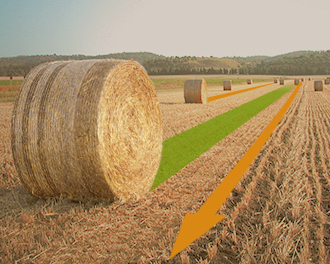FARM GROWN SOLUTIONS
In recent years netwrap has proven the preferred method of baling when using round balers. It offers many advantages over baler twine which lessen the impact of higher purchase costs over the earlier method.
The main points include:
- LESS WEAR AND TEAR ON THE BALER
Fewer revolutions of the bale are needed when net wrapping, dramatically reducing wear and tear on the baler.
- GREATER SPEED OF OPERATION
Reduced bale wrapping times improve output from the baler producing, on average, 15-20 more bales per hour than the twine method.
- BETTER COVERAGE ON THE BALE
Net wrapped bales maintain a more uniform shape, making transporting and handling easier, particularly important when wrapping silage bales on an automatic bale wrapper. Bale coverage from edge to edge is also essential when silage wrapping, eliminating air from the bale to ensure better quality forage.
- BETTER WEATHERING CAPABILITY
Net wrapped bales offer much a better weathering capability, allowing easier storage and reducing loss from crop wastage.
- EASIER TO REMOVE
Opening a net wrapped bale is a simple and straight-forward operation. The use of net eliminates the difficult and tiresome task of removing baler twine, especially in frosty conditions, and is also less likely to be picked up by livestock or machinery.
Every roll of Tama Round Bale Netting offers all the required essentials for successful and trouble-free baling.
The main points include:
- CORRECT LENGTH
All nets offered by Tama are manufactured to contain a guaranteed MINIMUM length. Whilst many other suppliers claim to have the correct length, in practice they are often found to be under their stated length. Tests have proven that many manufacturers do not guarantee the length of their net, which, at times, has been found to be up to 20% short, drastically increasing your cost per bale, even though you may have paid a considerably cheaper price for the net.
BE SURE TO CHECK THE MINIMUM GUARANTEED LENGTH! - CORRECT WIDTH
Rolls must be manufactured to 1.22m – 1.23m width to offer their best possible bale coverage. Either through inconsistent method of construction, or the net being produced a few centimeters too narrow, many makes of net cannot achieve this, resulting in less than adequate bale coverage, which can leave the bale with ‘shoulders’. Good bale coverage is critical on silage bales where air can become trapped in this area when wrapping, whilst dry crops are offered far better weather protection, easier storage and handling resulting in less crop loss.
BE SURE TO CHECK THE MINIMUM GUARANTEED WIDTH! - TIGHTLY WOUND ROLLS
A roll of net must have an outside diameter no greater than 30 centimeters to ensure correct fitting in all balers. Some makes of net are not wound sufficiently tightly to allow 3,000m on a 30 cm diameter roll, resulting in short length rolls and, consequently, less bales per roll.
BE SURE TO CHECK THE GUARANTEED ROLL DIAMETER! - EVENLY WOUND ROLLS
All rolls on netwrap must have absolutely straight and perfectly aligned ends, with the centre core clearly protruding at each end, to enable correct and efficient operation. If such badly wound rolls are used in balers where the net is free rolling inside the roll container, the ends of the roll can become damaged and eventually break the edge threads, resulting in badly wrapped and broken bales.
BE SURE TO CHECK EVENLY WOUND ROLLS! - CORRECT STRENGTH
All nets supplied by Tama are fully guaranteed in all of the above aspects and we guarantee every roll to perform correctly throughout every metre. Are you sure you are receiving the same guarantee from other suppliers?
IF NOT….WHY NOT?
Every roll of Tama Round Bale Netting guarantees all the required essentials for successful and trouble-free baling.
How much are you losing… and what is it costing you?
Many Contractors will spend more on Netwrap, over the lifetime of the baler, than on the actual cost of the baler itself.
Why, then, do so few take the time to check?
What is the true cost of a roll of netwrap?
TO MANY, one roll of net is much like another, a commodity product, purchased on price alone.
For them NETWRAP is NETWRAP is NETWRAP.
Not so…
Shorter length rolls or netwrap that is not strong enough can add an extra, un-planned cost to your business. If your chosen roll of netwrap does not deliver the expected number of bales, then more rolls will be needed to compete the baling. Likewise, if you need to add an extra half wrap of net to a bale to hold the crop securely, the additional net per bale will reduce the total number of bales possible from every roll.
All of this adds extra cost to your baling business
PRICE €100 per roll
3000M NETWRAP ROLL
300m short per roll = 30 bales LOST = €10 LOST
Extra half turn/bale = 45 bales LOST = €15.30 LOST
TOTAL €25.30 LOST
PRICE €120 per roll
3000M NETWRAP ROLL
300m short per roll = 30 bales LOST = €12 LOST
Extra half turn/bale = 45 bales LOST = €18 LOST
TOTAL €30 LOST
PRICE €140 per roll
3000M NETWRAP ROLL
300m short per roll = 30 bales LOST = €14 LOST
Extra half turn/bale = 45 bales LOST = €21 LOST
TOTAL €35.00 LOST
BENCHMARK TEST
Over the past 3 years, rolls of netwrap of all lengths and types, from most major manufacturers, were analysed in an accurate benchmarking investigation program. The testing procedure was carried out on a purpose – built testing device, manufactured in accordance with the certified testing design of DLG Test Centre.
The Benchmarking tests were conducted to discover the actual length and strength of many of the popular types of netwrap sold in the market today.
Roll Length
The results showed that more than 60% of ALL rolls tested were LESS than the stated length.
Rolls tested that were LESS than stated length
63 % of rolls short by MORE than 100m of stated length
21% of rolls short by MORE than 200m of stated length
8 % of rolls short by MORE than 300m of stated length
- The results clearly showed that 6 from every 10 rolls tested over the 3-season time period was more than 100m SHORT LENGTH.
- More than 20% of the rolls tested were over 200m SHORT LENGTH.
- 8% of ALL nets tested had over 300m SHORT LENGTH
This means that the price of a roll of netwrap with LESS than the stated length, will COST YOUR BUSINESS MORE.
Shorter length netwrap rolls mean the need to BUY MORE ROLLS.
As the ‘average’ 1.2m x 1.2m silage bale uses approximately 10-12m of net per bale, the result of SHORT LENGTH rolls could mean up to 25 FEWER bales per roll.
Netwrap Strength
The technology of round balers continues to increase, and the denser and much heavier bales put greater pressure on the netwrap used. Benchmarking tests carried out over the past 3-season period clearly showed that many nets nowadays are not strong enough for modern baling techniques.
% of rolls tested that were WEAKER than Tama Premium netwrap
- 52% of rolls tested were WEAKER than Tama Premium net average strength
![]()
- 20% of rolls tested were more than 25 kgf WEAKER than Tama Premium net average strength
![]()
- 12% of rolls tested were more than 40 kgf WEAKER than Tama Premium net average strength

The WEAKER netwrap will require more wraps of net per bale, so
considerably reducing the number of bales possible from each roll.
If you are buying SHORTER LENGTH and WEAKER netwrap…
how much is ‘cheap price’ netwrap really worth ?
When using Round Bale Netwrap, a few moments, must be taken to ensure correct preparation of your machine in order to achieve the best results. The most common problems of net splitting, tearing or fouling on feed rollers arise from the net ‘laddering’, where threads become broken, leading to a running stitch in the net running opposite to the direction of the net, eventually causing the net to separate where the ‘ladder’ has occurred. This can be caused by many different and varying circumstances but will always have the same ‘ladder’ effect.
- Check that the area in which the roll sits is free from dirt and debris. Ensure that all metal surfaces the net comes into contact with are free from rust or sharp edges or weld spots (net box sides, spreader bars and rollers etc.), or dried paint ‘lumps’ on any surfaces which could damage the net. Clean – up with emery paper if necessary. Also, check that the path for the net to the bale behind the feed mechanism is not dirty or rusty, which could restrict the net’s passage when feeding – often identified by a ‘lump’ of net at the start of the wrapping cycle.
This is especially important when starting baling after winter storage.
- Ensure the net is threaded correctly. Incorrect feeding of the net will cause incorrect tension being applied, leading to feeding and cutting difficulties which, in turn, will cause problems on subsequent net feed cycle. Where the net is fed through a series of fixed tension bars, always make sure these are clean and polished to avoid excessive friction.
Excessive net friction or an un – even surface will cause the net to tear.
- Where two rollers are used to feed the net, it is imperative these are correctly aligned and tensioned against one another, to enable the net to feed in evenly and under the correct tension. Incorrectly aligned rollers will produce a corresponding un-even net feed and, subsequent cutting action at the end of the wrapping cycle. This will result in poor bale coverage and possible net fouling on the feed rollers at the start of the next cycle. The rollers’ surface should also be closely inspected for abrasions or damage, which could snag the net when feeding.
- Ensure the feed rollers are clean of any moisture or residue.
NEVER use an aggressive cleaning agent such as petrol or turpentine to clean rubber roller.
- Always dust rubber rollers down with French chalk or talc powder when loading a new roll of netwrap, or use anti-static spray to reduce net static when operating.
This avoids the net fouling and wrapping around the rollers when feeding in.
- Carefully inspect the condition of the belt joiners on variable chamber balers for damage or worn connections, as this will snag the net and cause a tear, which will split the net on the bale.
- Make sure the knife or cutting surface is clean and un-damaged. Poor cutting action will result in an un-even ‘tail’ to the net, which can become tangled in the rollers and feed mechanism.
The number of round bales possible from any roll of netwrap is dependent on at least three things:
- The diameter of the bale produced
- The number of turns of net applied to the bale
and – most importantly
- The roll actually containing the length of net stated
The following table shows the approximate net use on varying sized bales in different crops.
These figures are given as guide and should only be used as an aid to operator usage when baling.
| Crop | Bale Size | No. of Turns |
Bales Per Roll 3150m XL |
Bales Per roll 3600m |
Bales Per Roll 4200m |
| Hay | 4’ diameter bale | 2-2.25 | 350-310 | 370-340 | 430-400 |
| 5’ diameter bale | 280-250 | 330-295 | |||
| Silage | 4’ diameter bale | 2.25-2.75 | 310-255 | 340-275 | 400-330 |
| Straw | 5’ diameter bale | 2-2.25 | 260-230 | 220-200 | 260-240 |
Many modern balers are equipped with a crop pre-cutting device which, when used in silage, can produce bales containing up to 20% more forage than a ’standard’ bale. This significantly increases the bale weight and density, and requires a corresponding increase in the amount of net that is used to hold the bale securely. Consequently, it is recommended that at least an extra 0.5 turns of net is applied to chopped silage bales. Likewise, when baling high density straw, it may also be necessary to increase the number of turns by at least 0.5 per bale to ensure it remains securely wrapped.





